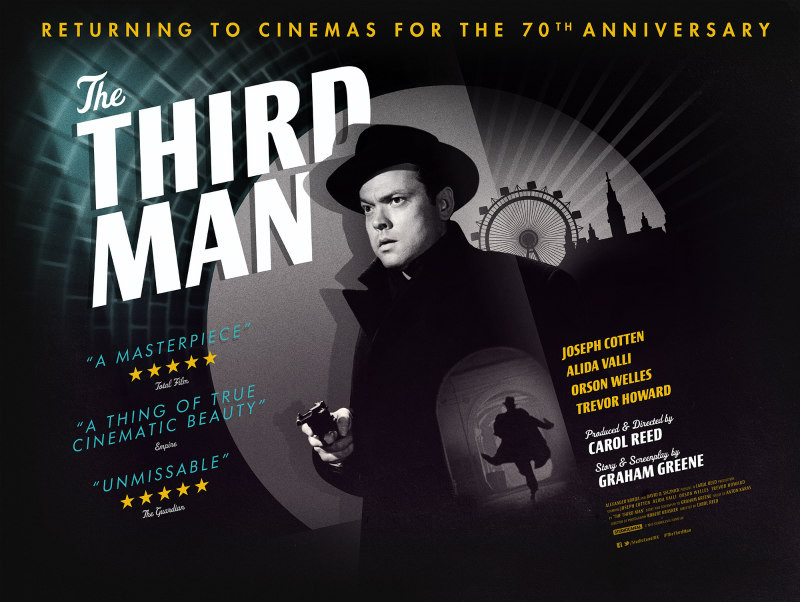Is there a more iconic image in noir history than a camera slowly zooming into a freshly illuminated Harry Lime (Orson Welles) staring straight into the eyes of his childhood friend, Holly Martins (Joseph Cotten) in The Third Man? 75 years later, Carol Reed's seminal film still remains a giant of the genre, the strangely playful tones of a zither ominously accompanying its brooding developments. Each of its elements possess a timeless quality, from its masterful camerawork blended with supreme chiaroscuro technique reminiscent of its German expressionist forebears, to its bleak, post-WWII narrative hopelessness, elucidating the copious amounts of destruction that has befallen Europe. It is reckless, unforgiving, and remains to be, arguably, the standard for which all film noir continues to follow — a high that they have been perpetually chasing ever since its release. Perhaps it is a pursuit for naught, as the shadow of influence that The Third Man ceaselessly casts over cinema grows alongside time itself.
American pulp novel author Holly Martins is searching for his old friend Harry Lime in the British sector of Vienna, Austria, only to be met with the news that he has died in a car crash. Martins is acquainted with Lime's girlfriend Anna (Alida Valli), and the pair soon discover that the accounts differ concerning Lime's supposed death. The porter from Lime's apartment claims to have seen a third man carrying Lime's body, but before he can flesh out his story, he is murdered. Martins confronts Major Calloway (Trevor Howard) and pleads for him to investigate the strange circumstances concerning his friend's demise, but reveals that Lime had been stealing Penicillin from military hospitals and selling a diluted version to the black market, which inadvertently injured and killed a lot of innocent civilians.
After Martins visits Anna, he encounters someone familiar on the streets: it's Harry, alive and well, who disappears into the darkness. Martins reports this to Calloway, who deduces that Lime has escaped through a series of underground sewers. In perhaps the film's most important sequence, Martins meets up with Lime at a carnival, and they converse in a ferris wheel cabin. Lime has no remorse for what he's done, claiming that all the victims were just crawling dots, collateral damage in his chase for remuneration. Later, Martins informs Calloway, and agrees to help the Police chase Lime, provided that they provide Anna with refuge from all of this. In a series of unfortunate events, Anna refuses the escape, and informs Lime of their plans. As Harry tries to escape, he is cornered by Martins in the sewers, and is shot offscreen. Lime's second funeral is a bleak affair for Martins — his old friend is dead, and Anna refuses to acknowledge his existence.
There are a myriad of ways that make The Third Man both a staple of noir, and a standout of the genre. Its utilization of conventions — the stark contrast between light and dark tones, and the utter despondency of its plot — is rooted in noir's pool of techniques, but they also carry a certain artistic flair to them. Each Dutch angle, zoom, and fluid movement of the camera coalesce into a bewitching series of images of mischief and intrigue. Take the film's most famous scene, for instance. Holly Martins chances upon a great revelation as he walks along the cobblestone street. A beam of light from an adjacent apartment illuminates the smug Harry Lime's face. He's alive and well, and with more gusto than ever. The framing of this sequence is simply a sight to behold. The simple closing in of a camera towards Lime's face becomes extremely significant due to its context. By itself, it is a technical undertaking with great aesthetic value, albeit rudimentary.
However, this is a character that we have been talking for ages about, by this point in the film, the main source of intrigue that drives the entire operation. Put those two together, and it becomes something akin to an erupting volcano, an explosion of both answers and questions, gluing spectators to their seats, anxiously waiting for what is to come. Orson Welles is a scene stealer, and his character introduction gives viewers a taste of what they are about to experience, which is a complex tale that goes beyond the ordinary, and has an antagonist that you hate to love. Simply put, these few minutes on celluloid, much like the entirety of The Third Man, rise above everything else because of its understanding of its genre's conventions, while raising the stakes.
To simply brand The Third Man as a timeless classic is a great disservice to the titanic impact it has had on the cinematic landscape. Taking inspiration from movements expressed in films before it such as Alfred Hitchcock's The Lady Vanishes, Fritz Lang's Ministry of Fear and Jean Negulesco's The Mask of Dimitrios, the film envelops it in a transnational blanket of a war-torn world. Because of this, its reception changes widely depending on one's place of origin. William Cook notes that in Britain, it's a thriller tackling the themes of friendship, betrayal, and its consequence-filled intricacies, while in Vienna, it turns into a melancholic examination of its past. Such is the breadth of what this film espouses, exemplified by the moral decay that flows in the spirit of its antagonist, Harry Lime. Despite only appearing for a third of the film, Lime becomes the central tenet to this film's themes. Here is a man who simply refuses to abide by the standards the world brandishes. The war has torn him down, killed his younger, hopeful self, and he goes about his days without any yearning for lightness of being, and you can't get any more noir than that.
In today's day and age, The Third Man still feels fresher than ever. More than anything else, the camerawork in this film feels like it was shot yesterday, and its striking moral conundrum of doing what is best for oneself without thinking of what it may do to others is a timely thought worth pondering. Are there noirs that delve deeper into the human psyche, or present the world in a much more maligned vision, with visuals that The Third Man would pale in comparison to? Absolutely, but there is no other noir that flawlessly blends all of these elements together like The Third Man, the result of which is a seamless product, considered to be one of the finest films of all time. Noir still enjoyed a great post-Third Man period of success, but all of them either paid homage to Reed's masterpiece, or were frantically chasing a cursory ersatz glory akin to it.
The success of the film spawned a radio drama series called The Adventures of Harry Lime, as well as appearances of its iconic antagonist in several comic books. The construction of a museum in its honor in Vienna, Austria stands as a testament to the impact it has had on moviegoers. 75 years after its release, the film continues to stand as the penultimate example of film noir's essence: the denuded, hard-boiled world of private eyes and femme fatales filled with false senses of aspirations brought down by the unforgiving indifference of human existence.

















